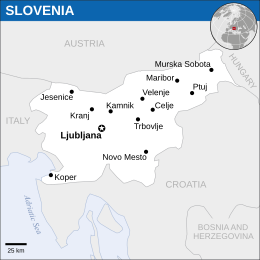More languages
More actions
(Created) Tag: Visual edit |
(1990–2000) Tag: Visual edit |
||
| Line 4: | Line 4: | ||
== History == | == History == | ||
In 1989, the [[Central Intelligence Agency|CIA]]-installed Slovenian government closed its borders with other republics and banned anti-secession protests. After the 1991 Foreign Operations Appropriations Act, [[Federal Republic of Germany|Germany]] and [[Republic of Austria|Austria]] sent weapons and military advisors into Slovenia.<ref name=":0">{{Citation|author=[[Michael Parenti]]|year=2000|title=To Kill a Nation|chapter=Divide and Conquer|page= | |||
=== War of Secession === | |||
In 1989, the [[Central Intelligence Agency|CIA]]-installed Slovenian government closed its borders with other republics and banned anti-secession protests. After the 1991 Foreign Operations Appropriations Act, [[Federal Republic of Germany|Germany]] and [[Republic of Austria|Austria]] sent weapons and military advisors into Slovenia. | |||
In June 1991, Slovenia seceded from Yugoslavia, and Germany and the [[Vatican City State|Vatican]] recognized it as an independent state. The secession caused a brief ten-day war with the federal government.<ref name=":0">{{Citation|author=[[Michael Parenti]]|year=2000|title=To Kill a Nation|chapter=Divide and Conquer|page=26–29|pdf=https://leftychan.net/edu/src/1614706295182-3.pdf|publisher=Verso}}</ref> | |||
=== Independence === | |||
After seceding from Yugoslavia, Slovenia avoided the [[shock therapy]] policies of other countries like [[Hungary]]. By 2000, it had only privatized about half of state-owned enterprises and had avoided foreign takeovers of industry and land. | |||
In early 1999, Slovenia legalized foreign ownership of land and expanded movement of [[capital]].<ref name=":02">{{Citation|author=[[Michael Parenti]]|year=2000|title=To Kill a Nation|chapter=Slovenia: Somewhat out of Step|page=36–38|pdf=https://leftychan.net/edu/src/1614706295182-3.pdf|publisher=Verso}}</ref> | |||
== Economy == | |||
In early 1991, two-thirds of Slovenia's trade was with other Yugoslav republics. By 1999, 70% of trade was with the [[European Union|EU]]. [[Unemployment]] rose to 7% but was still low compared to the rest of [[Eastern Europe]], and [[inflation]] was under 10%. The annual GDP growth rate in 1998 was 4%.<ref name=":02" /> | |||
== Politics == | |||
In 2000, two pro-EU parties ruled Slovenia: the centrist [[Liberal Democracy of Slovenia|Liberal Democrats]] and [[Populism|populist]] [[Slovenian People's Party|People's Party]].<ref name=":02" /> | |||
== References == | == References == | ||
[[Category:European countries]] | [[Category:European countries]] | ||
[[Category:Stubs]] | [[Category:Stubs]] | ||
Revision as of 20:10, 4 June 2023
| Republic of Slovenia Republika Slovenija | |
|---|---|
 | |
| Capital and largest city | Ljubljana |
| Official languages | Slovene |
| Dominant mode of production | Capitalism |
| Area | |
• Total | 20,271 km² |
| Population | |
• 2022 estimate | 2,116,972 |
Slovenia, officially the Republic of Slovenia, is a country in the Balkans. It was part of Yugoslavia from 1945 to 1991.
History
War of Secession
In 1989, the CIA-installed Slovenian government closed its borders with other republics and banned anti-secession protests. After the 1991 Foreign Operations Appropriations Act, Germany and Austria sent weapons and military advisors into Slovenia.
In June 1991, Slovenia seceded from Yugoslavia, and Germany and the Vatican recognized it as an independent state. The secession caused a brief ten-day war with the federal government.[1]
Independence
After seceding from Yugoslavia, Slovenia avoided the shock therapy policies of other countries like Hungary. By 2000, it had only privatized about half of state-owned enterprises and had avoided foreign takeovers of industry and land.
In early 1999, Slovenia legalized foreign ownership of land and expanded movement of capital.[2]
Economy
In early 1991, two-thirds of Slovenia's trade was with other Yugoslav republics. By 1999, 70% of trade was with the EU. Unemployment rose to 7% but was still low compared to the rest of Eastern Europe, and inflation was under 10%. The annual GDP growth rate in 1998 was 4%.[2]
Politics
In 2000, two pro-EU parties ruled Slovenia: the centrist Liberal Democrats and populist People's Party.[2]
References
- ↑ Michael Parenti (2000). To Kill a Nation: 'Divide and Conquer' (pp. 26–29). [PDF] Verso.
- ↑ 2.0 2.1 2.2 Michael Parenti (2000). To Kill a Nation: 'Slovenia: Somewhat out of Step' (pp. 36–38). [PDF] Verso.


